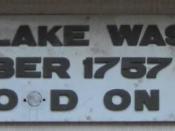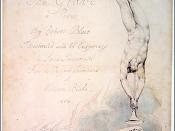Rhythm In William Blake's Poem "London"
Rhythm, in a most basic sense, is a pattern of recurring sounds in the different syllables of words. Rhythm acts as a kind of "invisible framework" to poetry as it can only be heard and cannot be seen. George Puttenham describes the effect of rhythm as "(Something) to inveigle and appasionate the mind" (Mason and Nims 201), which succeeds in demonstrating the essence of rhythms role in poetry.
William Blake's poem entitled, "London" uses rhythm to reinforce the ideas conveyed in the poem by employing diction that mimics the confined and restricted feeling conveyed by the bleakness in the streets of London. Beginning with the poems title, we expect a poem to be descriptive or a reminiscence of a particular time or place. The word "London" traditionally evokes images of Buckingham Palace or the royal family, yet Blake's poem makes no mention of either of these images and instead draws attention to the nuances in connotation.
In this case, Blake focuses on the bleak quality of life in London rather than the great palace or the elite royalty.
"London" was written in 1794, during the time of the French Revolution. The revolution led to political panic, causing authorities in England to muffle various freedoms that had been afforded to its citizens, which ultimately created a country of strict regulations and increasing unhappiness.
Blake's poem does not turn its back on the blackened streets of London, but instead guides us through the midnight streets, all the while painting the picture of a dark and dirty London. As the speaker wanders through the streets, he takes note of the frailty and grief that he sees in the faces of the people that he meets. He...


